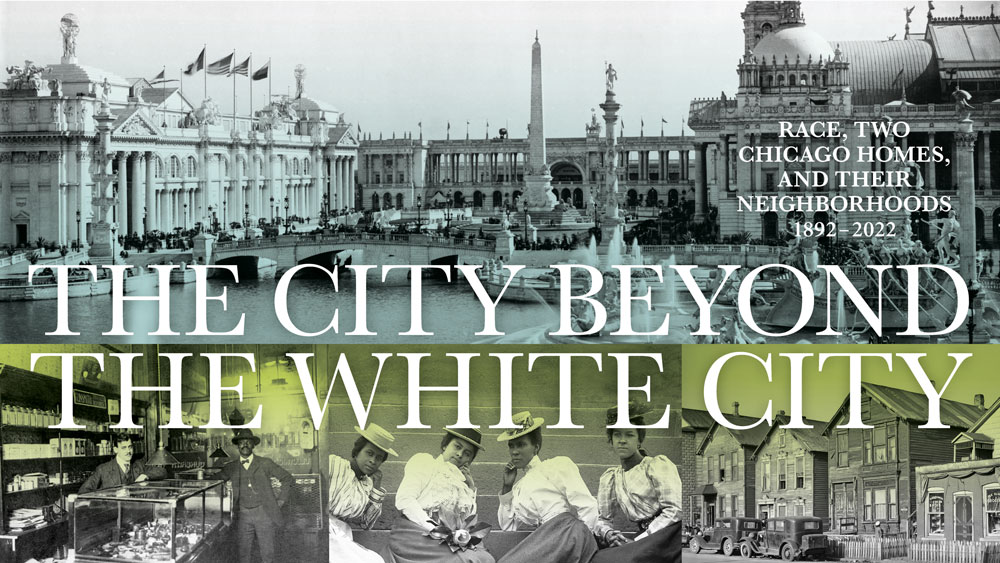
Exhibition Explores the History of Race and the Built Environment in Chicago through the archaeology of the 1893 World’s Columbian Exposition, the Charnley-Persky House and the Mecca Flats
Exhibition Dates: November 3, 2022–October 28, 2023
Physical Exhibit: Charnley-Persky House, 1365 N. Astor St., Chicago
Virtual Exhibit: beyondthewhitecity.org (launches November 3, 2022)
Opening at the Charnley-Persky House Museum on November 3, 2022, The City Beyond the White City: Race, Two Chicago Homes, and their Neighborhoods, connects the 1893 World’s Columbian Exposition, also called the “White City,” to the material, spatial, and social histories of two 1892 structures—the Charnley-Persky House and the Mecca Flats—located respectively on Chicago’s privileged Near North and disinvested Near South Sides. The physical exhibition, featuring archaeologically recovered artifacts, is accompanied by a virtual exhibit; together they frame the history of race, structures of racism, and the built environment in Chicago.
The City Beyond the White City features over 30 individual artifacts excavated from the Charnley-Persky House (Adler & Sullivan, 1891–1892) and from the former Mecca Flats (Edbrooke & Burnham, 1891–1892). Together, archival documents, oral histories, and 19th- and early-20th-century artifacts unearthed in archaeological digs are used to interpret a nuanced public history of race and place in Chicago for student and public audiences.
The exhibition is co-curated by Dr. Rebecca Graff, associate professor of anthropology at Lake Forest College, and the late Pauline Saliga, former executive director of the Society of Architectural Historians and the Charnley-Persky House Museum Foundation.
“The structures themselves—the Charnley-Persky House and the Mecca Flats—set the stories of those who lived there in motion,” said Dr. Graff. “But ultimately, this exhibition is an intervention between unpeopled architectural histories and narrativity about race and racism in Chicago that lacks a connection to the built environment and human experiences of place, not least the historic experiences of racism in Chicago. Archaeological insights plus architectural histories help to get us there.”
The exhibition is organized thematically into four sections. The first section, “Race and the World’s Fair Marketplace,” looks at the Fair as a literal marketplace for commodities and an ideological marketplace for schemes on race. Late-19th-century racial ideologies are not always central to discussions of sites of architectural significance. But to understand people’s experiences of the built environment on three scales—the neighborhoods, the buildings, and the objects they left behind—the exhibit starts with the racial ideologies that suffused the 1893 Fair to see how they were made material at home.
The second section looks at consumption, health, and sanitation in turn-of-the-century Chicago. Contrary to what might be expected, the people who lived and worked in the Charnley House and in the Mecca Flats at the turn of the 20th century shared similar challenges to their health and sanitary infrastructure—ones that defied a simple socioeconomic pattern.
Ideologies of the domestic sphere and the women, domestic servants, and children who formed it, were undergoing a rapid transformation. Racialized notions of American womanhood, in part impacted by the ratification of the 20th Amendment, played out differently at the three sites. “Women, Children, and the Domestic Sphere,” focuses on six notable women from the three sites: Nancy Green and Sophia Hayden; Helen Charnley and Marion Stephens; and Madame Nobia A. Franklin and Gwendolyn Brooks. Each of these women highlight the social history that converges around the sites. The section also looks at the children of Bronzeville and the Gold Coast, and the racialization of domestic laborers at the Mecca Flats and the Charnley House.
The final section, “Urban Renewal and Racial Ideology,” is perhaps the most significant because it forces the viewer to confront the lingering inequities built into American cities like Chicago. Mid-20th-century federal and state urban renewal programs built upon the slum clearance legislation of the 19th century, destroying countless historic structures and vital neighborhoods largely without considering the interests and desires of the affected communities. Some of the most egregious examples of this in Chicago took place in Bronzeville, but the Gold Coast also experienced this destruction.
The Society of Architectural Historians will host an opening reception for the exhibition on Thursday, November 3, at the Charnley-Persky House, from 5:30 pm to 7:30 pm. Reservations are required as space is limited. Reserve tickets online.
Exhibition Hours: The exhibition is open Wednesdays and Saturdays from 11:00 am to 1:00 pm. No reservations are required.
Group Tours: Group tours of the exhibition and Charnley-Persky House are available by appointment only. To schedule a group tour, please call 312-573-1365 or email Anne Bird at abird@sah.org.
The City Beyond the White City: Race, Two Chicago Homes, and their Neighborhoods has been made possible through the support of SAH, Lake Forest College, the Mellon Foundation, Illinois Institute of Technology, and by a grant from the National Endowment for the Humanities: Sustaining Humanities through the American Rescue Plan in partnership with the American Historical Association.

Any views, findings, conclusions, or recommendations expressed in this exhibition do not necessarily represent those of the American Historical Association or the National Endowment for the Humanities.